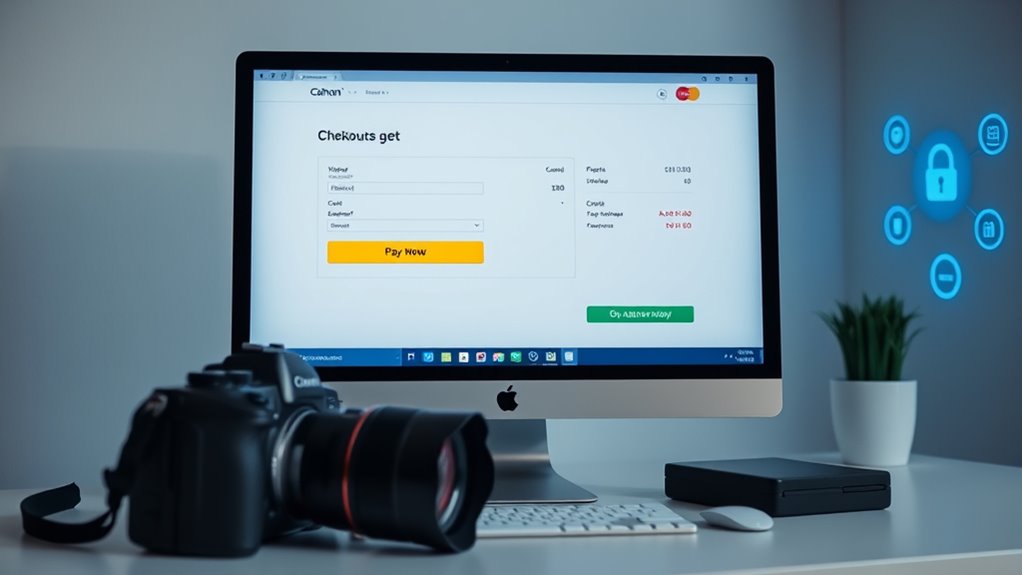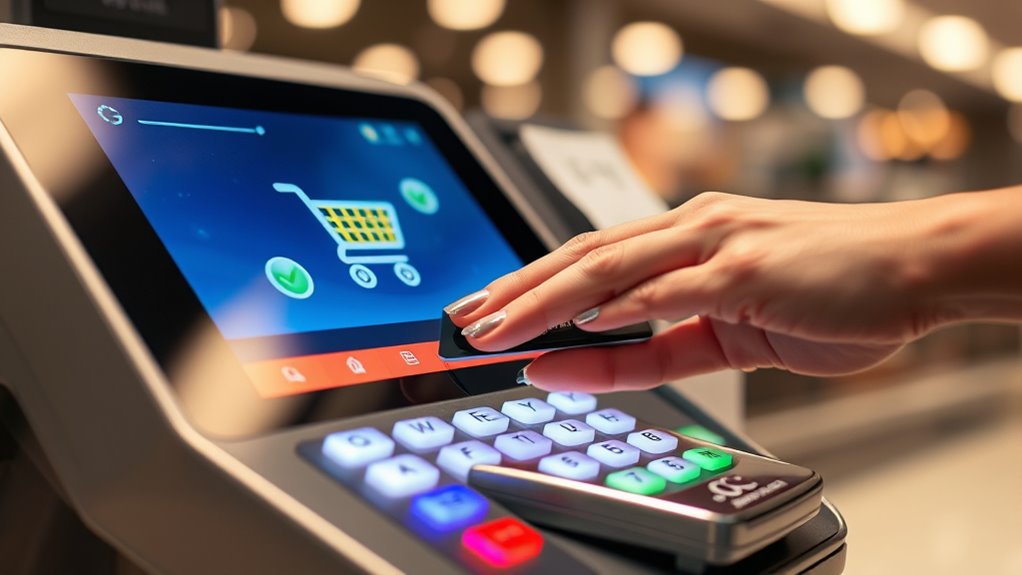When you make a purchase, the payment gateway securely encrypts your payment details and sends them to the payment processor or bank for verification. It checks if your account has sufficient funds and runs fraud prevention measures. Once authorized, the gateway confirms the transaction and settles the funds into the business’s account, often within seconds. If you want to understand how this seamless process keeps your information safe, there’s more to explore.
Key Takeaways
- The customer initiates a purchase, prompting the gateway to encrypt payment details for secure transmission.
- The gateway forwards encrypted data to payment processors or banks for verification.
- Verification includes checking funds, performing fraud checks, and assessing transaction legitimacy.
- Once approved, the gateway communicates authorization back to complete the transaction.
- Funds are settled, and confirmation messages are sent, with security standards like PCI DSS maintained throughout.

Payment gateways serve as the critical link between your customers’ payment methods and your business’s bank account. When someone shops on your site or in your store, the gateway acts as the secure channel that transmits payment information from the customer to you. Modern payment gateways support a variety of payment options, including traditional credit and debit cards, mobile payment solutions, and even cryptocurrency integration. This flexibility ensures your customers can pay using their preferred method, which can boost sales and improve user experience.
Payment gateways connect customers’ payment methods securely to your business’s bank account, supporting various payment options for seamless transactions.
Once the customer initiates a purchase, the payment process begins. The gateway encrypts their payment details to protect sensitive data during transmission. If your customer chooses to pay via mobile payment solutions like Apple Pay or Google Pay, the gateway processes these seamlessly, leveraging tokenization for added security. For cryptocurrency payments, the gateway converts digital currencies into fiat or directly processes the blockchain transactions, allowing customers to pay with their digital assets without leaving your platform. This integration requires specialized infrastructure but opens up new revenue streams and appeals to tech-savvy buyers.
After encryption, the gateway forwards the payment request to the relevant payment processor or acquiring bank. This step involves verifying the details and ensuring the customer’s account has sufficient funds or digital assets. The gateway also performs fraud checks and risk assessments at this stage to prevent unauthorized transactions. If everything checks out, the processor approves the payment, and the approval status is sent back through the gateway to your system. This entire process typically happens within seconds, providing a smooth checkout experience. Additionally, security standards such as PCI DSS are maintained throughout to ensure sensitive data remains protected.
Once approved, the gateway generates a confirmation message to the customer and notifies your business’s bank to transfer the funds. In the case of cryptocurrency, the blockchain transaction confirms the transfer of digital assets, which is then reflected in your account once verified. For traditional payments, the funds are usually settled within a few business days. Throughout this process, the gateway maintains compliance with security standards such as PCI DSS, ensuring sensitive data remains protected.
Frequently Asked Questions
How Do Payment Gateways Handle International Currency Conversions?
When handling international currency conversions, payment gateways perform currency exchange by converting the transaction amount into the merchant’s currency, often using real-time exchange rates. For cross-border payments, they guarantee seamless transactions by automatically applying the latest rates and fees. You benefit from accurate conversions, minimizing surprises, and enabling smooth global transactions. The gateway’s role is to facilitate secure, quick currency exchange, making cross-border payments efficient and hassle-free for you and your customers.
What Security Measures Prevent Fraud During Transactions?
Think of your transaction as a guarded fortress. You’re protected by biometric authentication, like a fingerprint or facial scan, serving as your personal key. Fraud detection algorithms act as vigilant sentinels, constantly scanning for suspicious activity. These combined security measures create a strong barrier, preventing unauthorized access and fraud. You can shop confidently, knowing your payment gateway employs advanced technology to keep your transactions safe and secure.
How Do Payment Gateways Integrate With Various E-Commerce Platforms?
You’ll find that payment gateways integrate smoothly with various e-commerce platforms through APIs and plugins, making setup easy. During merchant onboarding, they provide customer support to assist with integration and troubleshooting. You simply connect the gateway to your platform, configure settings, and guarantee security measures are in place. This seamless integration allows for secure transactions, quick checkout experiences, and reliable support, helping your business run efficiently.
What Are the Common Reasons for Transaction Declines?
You might experience transaction declines due to fraud prevention measures or customer verification issues. Payment gateways flag transactions if they suspect fraud or if details don’t match records, leading to declines. Insufficient funds, expired cards, or incorrect information also cause declines. To avoid this, make certain your billing info is accurate, verify your identity when asked, and use secure payment methods. This helps streamline approval and reduces unnecessary declines.
How Do Payment Gateways Manage Recurring Billing and Subscriptions?
Imagine your payment gateway as a diligent conductor, orchestrating your subscription management effortlessly. It automatically handles billing cycles, ensuring payments process smoothly without your intervention. By securely storing customer payment details, it manages recurring billing, charging customers at specified intervals. This automation reduces errors, keeps subscriptions active, and improves customer experience—making sure your business runs seamlessly while you focus on growth, not manual billing worries.
Conclusion
Now that you understand how payment gateways act as the heartbeat of online transactions, you see how they transform your checkout into a seamless dance of trust and security. Each step, from entering details to authorization, is a stroke in the greater painting of commerce. Like a lighthouse guiding ships safely to harbor, gateways illuminate the path, ensuring your payment journey flows smoothly. Embrace this rhythm, and your online experience becomes a symphony of confidence and convenience.









